|
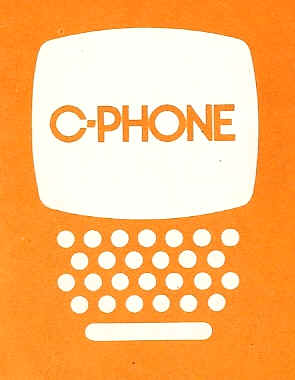
Stock
Prospectus
C-Phone,
Inc. and PocketPhone, Inc.
(From the Paul and Sally Taylor Collection at
SMECC.)
It
was not until 1968 that deaf people could communicate with each other
over the telephone without the assistance of a hearing person as an
intermediary. Thanks to R.H. Weitbrecht, a deaf radio ham (W6NRM), the
first practical acoustical coupler was developed and marketed by Applied
Communication Corporation in 1967. Using obsolete but otherwise in good
working condition teletypewriters were obtained from Western Union Co.
and Western Electric Co. (a subsidiary of A.T.&T.) to be used at
both ends of the telephone by deaf people. The acoustical couplers
served as a translator which translated electrical signals from the
teletypewriters into sound and vice versa. Each letter or
number had a distinct sound which were transmitted over the
telephone lines just like voices. The concept of communicating, over the
phone with teletypewriters caught on quickly over the past ten years,
resulting in approximately 30,000 units across the country serving their
deaf owners in a very critical way.
Besides being able to communicate, they were able to get in
touch with hospitals, police stations, fire stations, department stores,
etc. through either their own teletypewriter units or a professional
answering service.
In
1972, it became apparent that the supply of obsolete units were
dwindling fast and that deaf people would have to resort to the purchase
of new teletypewriter units costing above $750 or the new electronic
units which were coming out for the first time at equally unaffordable
prices. A group of St. Louis, Missouri teletypewriter
installers/repairmen who happen to be deaf themselves and who helped the
St. Louis network grow from two in 1967 to over 300 deaf telephone
subscribers decided to band together and develop an all-electronic
device to replace the mechanical teletypewriter units at a price
affordable by the deaf
people. On February, 1975, Eugene McDowell, Frederick Stewart,
Ralph McLaughlin, Thomas Schwarz, and Paul Taylor began developmental
work on an all-electronic unit, beginning with the keyboard design.
Sometime in the summer of 1975, a good friend of Gene McDowell and
Paul Taylor, an electronics designer by the name of Dave Scharon joined
in the development to accelerate the progress. After three years of
on-off joint efforts in their part-times, the C-Phone telecommunication
unit was finally fully developed and demonstrated for the first time at
the 1978 National Association of the Deaf convention. Reaction to the
unit was immediate; units started selling the following November and has
continued to this day on an average of 15 units per week at $550 each.
Over 500 units has been sold to this day after seven months on the
market.
The
C-Phone unit is presently manufactured by a subcontractor which makes
their own products somewhat related to the C-Phone in appearance but are
used in the computer field in business and industry. Due to unexpected
demand for the C-Phone in present quantities, the subcontractor has not
been able to supply enough units to avoid a huge backlog which now
numbers 150 and delivery time is anywhere from eight to sixteen weeks.
In addition, the subcontractor wishes to raise their prices by 20%
which of course means that C-Phone must pass them on to their deaf
customers. This violates the general philosopy on which the C-Phone
company was founded - the manufacture of a telecommunication unit at
affordable prices for deaf people to enable as many to use the telephone
which, in this day, has become a priceless commodity in our everyday
lives to function effectively in a highly competitive world. Furthermore,
many orders have been cancelled after the customers learned of the long
delivery times.
To
consistently meet delivery schedules and to meet the heavy demand at
reasonable prices, it was decided that an independent manufacturing
facility operated by C-Phone would be appropriate. In the meantime,
another electronics outfit by the name of Pocket-Phone who happens to be
staffed by the same electronics designer, Dave Scharon, and an
electronic chip programmer, Tom Monsees, who did all the programming
work for the C-Phone electronic chips asked to be included in the
manufacturing facility so that greater efficiencies can be realized with
higher volume work and parts. Pocket-Phone sales have exceeded 600 units
since its beginnings last January of this year. The Pocket-Phone is an
extremely compact unit weighing only one pound and its readout is 16
characters long. It presently sells for $167.50 which is the lowest
priced self contained telecommunication unit for the deaf in the world.
The Pocket-Phone is an excellent complement to the C-Phone unit because
of its high portability and it costs only a third of the much larger
C-Phone unit with its 12 inch screen containing 1,704 characters. The
Pocket-Phone units are presently manufactured in the basement of Mr.
Scharon's home.
A
merger between C-Phone, Inc. and Pocket-Phone, Inc. is foreseen because
the two outfits complement each other in many ways. The technical
expertise of Pocket-Phone, Inc. and the proven success of C-Phone's
marketing strategies due to the fact that the C-Phone, Inc. founders are
themselves deaf and have many contacts throughout the deaf world will
prove to be a combination that will ensure that highly reliable
telecommunication units will be made affordable to the majority of deaf
people throughout the world. Capital raised from the sales of either
stocks or bonds will be used primarily to finance the acquisition of
parts in large volumes to take advantage of lower prices and the
establishment of a nominal facility in which units can be manufactured
free from subcontractor's limitations or restrictions.
After
the establishment of the new merged company, other products will be
investigated as to their reliability and cost such as baby cry
signalers, wakeup clocks, smoke alarm detectors, etc. If it can be
determined that advanced technology can produce similar items at lower
cost and at greater reliability, they will be manufactured by the new
company for deaf people's benefits.
Another product seriously under consideration is the design and
manufacturing of television decoders which will enable deaf people to
understand TV programs from an audio standpoint by the way of
inserting captions on their individual sets. In 1980 and 1981, TV
stations will begin to broadcast captions on their stations which will
be picked up only by TV sets equipped with decoders.
If you wish to be part of our philosophy of providing deaf
people with numerous aids at reasonable prices that will enable them to
function more normally in a highly competitive hearing world, won't you
take an interest in our company either with your moral support or your
intent to purchase stocks which could provide you with growth and
dividends over the years to come? Thank
you for your interest.
|
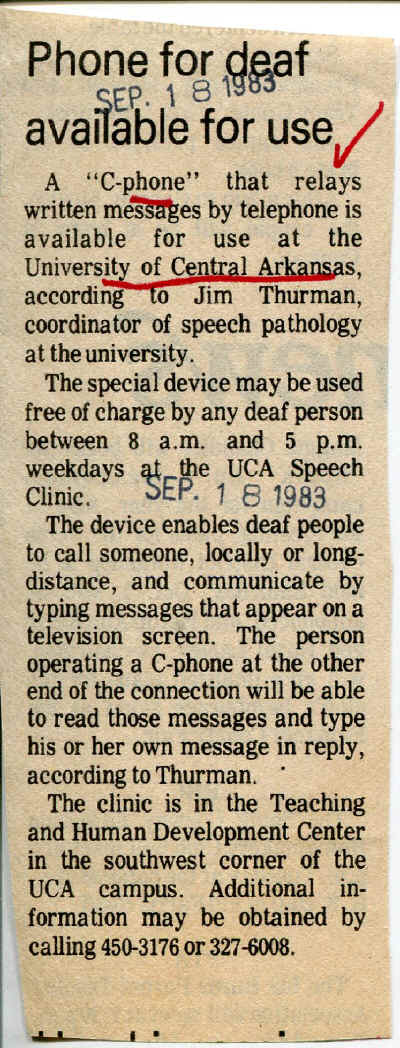
Does anyone have any photographs
of this C-Phone installation ?
Tell us more about Jim Therman...
|
|
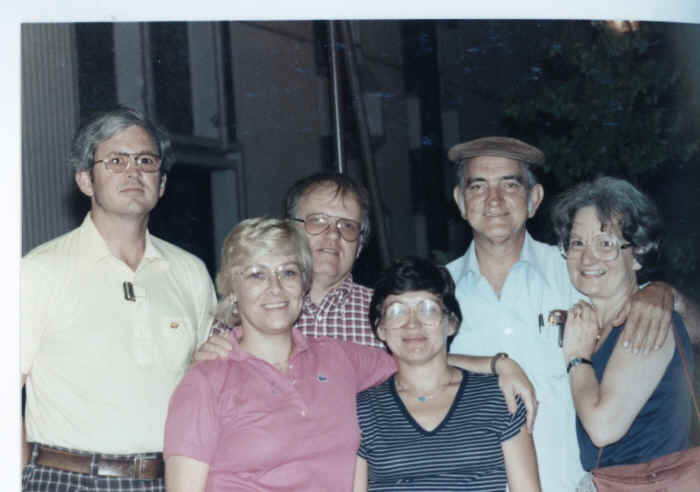
From the Paul and Sally Taylor Collection at
SMECC.
*The CPhone Gang...Ralph & Peggy McLaughlin; Gene & Gloria McDowell, and Paul & Sally Taylor, taken
1982 at the NAD Convention in St. Louis .

From the Gene and Gloria McDowell Collection as SMECC
Later Photo Year? After Paul Taylor and Fred Stewart had left the
company -
- Gene & Gloria McDowell, Ralph & Peggy McLaughlin and
Tom and Lucy Schwarz
(need to double check on date)
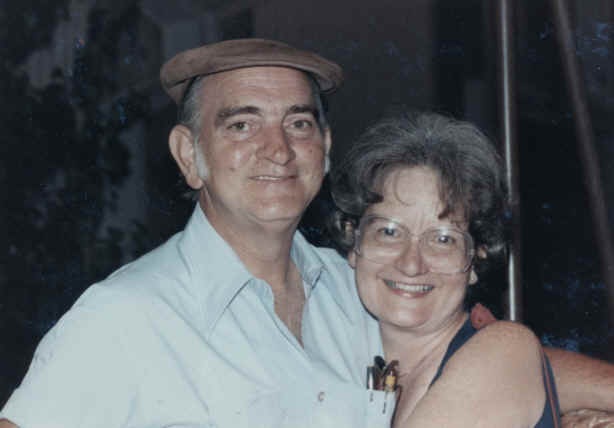
From the Paul and Sally Taylor Collection at
SMECC.
Ralph & Peggy McLaughlin
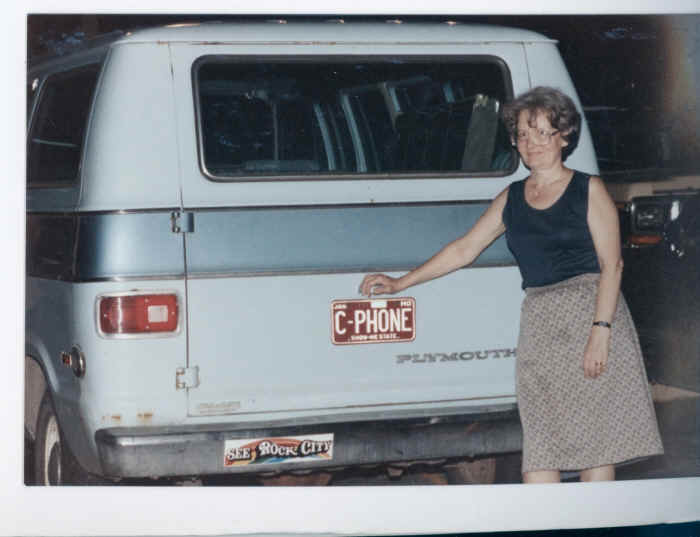
From the Paul and Sally Taylor Collection at
SMECC.
Peggy McLaughlin with the C-Phone license plate.
|
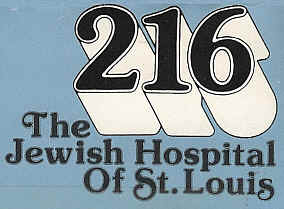 September/October 1981
September/October 1981
(From the Paul and Sally Taylor Collection at
SMECC.)
The hospital's recommitment to its obstetrics department has brought on a flurry of new programs and services, such as Super Siblings. Prospective siblings, getting their first look at a newborn baby, peer through the nursery window as Obstetrics Nurse Debbie
Schmaleng, R.N., displays a recent arrival. See page 2
Access for the Hearing-Impaired Patient
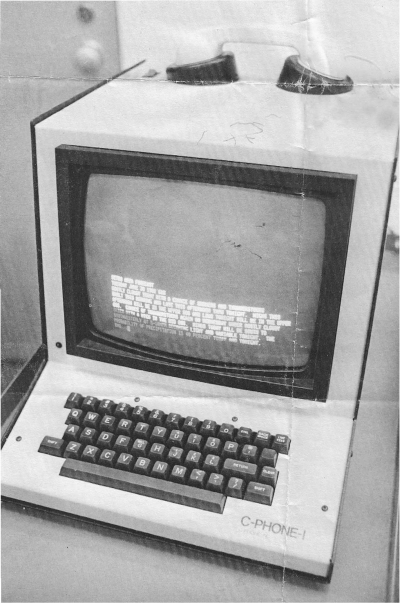 The lightweight, solid-state C-Phone is manufactured in Chesterfield, Mo., by a three-man corporation; two of the members are deaf. It has a standard typewriter keyboard and special signals travel in and out of the device via a telephone receiver. Deaf users type a message, which appears on the screen, either to another TTY user or to Contact's TTY. At Contact, a volunteer takes the message and relays it to the hearing person by voice. Hearing persons contact the hearingimpaired in the opposite manner. The lightweight, solid-state C-Phone is manufactured in Chesterfield, Mo., by a three-man corporation; two of the members are deaf. It has a standard typewriter keyboard and special signals travel in and out of the device via a telephone receiver. Deaf users type a message, which appears on the screen, either to another TTY user or to Contact's TTY. At Contact, a volunteer takes the message and relays it to the hearing person by voice. Hearing persons contact the hearingimpaired in the opposite manner.
Responding to the needs of the area's deaf community, The Jewish Hospital of St. Louis has become one of the three local hospitals to provide TTY (teletype) services for hearing-impaired patients.
TTYs are special home teletype devices that enable the deaf to-contact other
hearing-impaired persons via telephone. Patients at Jewish Hospital also will join about 500 area residents who utilize Contact, a St. Louis-based volunteer organization that forwards TTY messages from the deaf to hearing persons and vice-versa.
Without contact, the deaf could only communicate with other TTY users; now they can reach almost anyone. Users can also call special numbers to receive news summaries and weather reports.
Although the TTY service is a relatively simple procedure, it is nevertheless an important one because it provides the hearing-impaired patient the independence and privacy that hearing people often take for granted.
Jewish Hospital TTY services are borne of a concerted effort by Thomas Covey, M.D., and the Associates In Medicine, the hospital's community relations group. Dr. Covey, assistant director of the department of surgery, had expressed a desire to provide TTY services for hearing-impaired patients; the Associates responded by purchasing a C-Phone, a contemporary, sophisticated TTY that employs a television screen. Best of all, the C-Phone is portable and easy to operate.
Seven hospital employees now can prepare the unit for use, and the C-Phone is available around the clock. Arrangements for the unit's use and training was coordinated by Director of Volunteer Services Elaine Levinsohn, who also has advised
several local institutions of the C-Phone's availability, including the Central Institute for the Deaf. ~
|
|
C PHONE SPECIAL
SALE! Let Your Fingers Do The Talking
FRIDAY, APRIL 15, 1983 SATURDAY, APRIL 16, 1983 |
| |
|
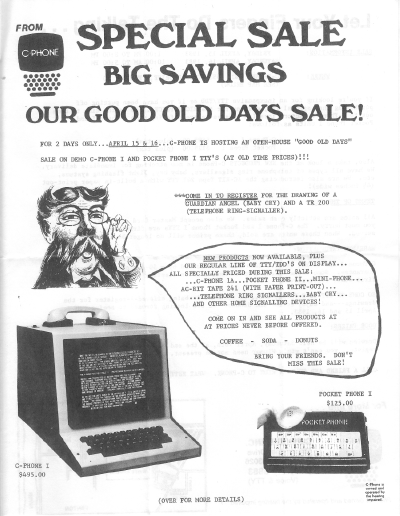 |
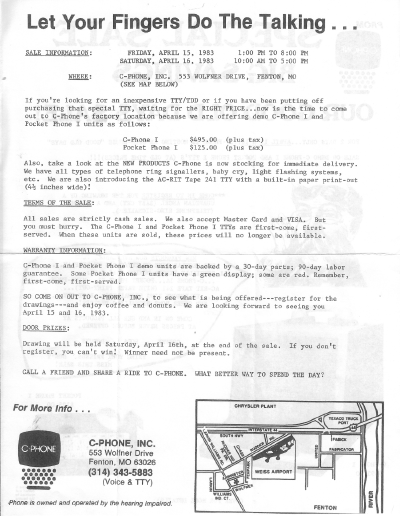 |
|
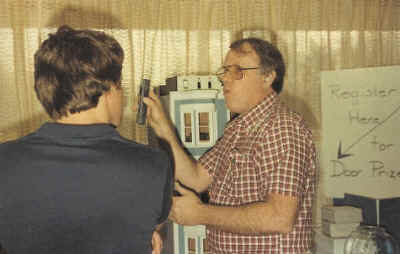
From the Gene and Gloria McDowell Collection
at SMECC
Gene McDowell President C-Phone
at C-Phone Open
House
|
|
Let Your Fingers Do The Talking
• • •
SALE INFORMATION:
FRIDAY, APRIL 15, 1983 SATURDAY, APRIL 16, 1983
1:00 PM TO 8:00 PM 10:00 AM TO 5:00 PM
WHERE:
C-PHONE, INC. 553 WOLFNER DRIVE, FENTON, MO (SEE MAP BELOW)
If you're looking for an inexpensive TTY/TDD or if you have been putting off purchasing that special TTY, waiting for the RIGHT PRICE ••• now is the time to come out to C-Phone's factory location because we are offering demo C-Phone I and Pocket Phone I units as follows:
C-Phone I Pocket Phone I
$495.00 $125.00
(plus tax) (plus tax)
Also, take a look at the NEW PRODUCTS C-Phone is now stocking for immediate delivery. We have all types of telephone ring signallers, baby cry, light flashing systems, etc. We are also introducing the AC-RIT Tape 241 TTY with a built-in paper print-out (4~ inches wide)!
TERMS OF THE SALE:
All sales are strictly cash sales. We also accept Master Card and VISA. But you must hurry. The C-Phone I and Pocket Phone I TTYs are first-come, firstserved. When these units are sold, these prices will no longer be available.
WARRANTY INFORMATION:
C-Phone I and Pocket Phone I demo units are backed by a 30-day parts; 90-day labor guarantee. Some Pocket Phone I units have a green display; some are red. Remember, first-come, first-served.
SO COME ON OUT TO C-PHONE, INC., to see what is being offered---register for the drawings---and enjoy coffee and donuts. We are looking forward to seeing you April 15 and 16, 1983.
DOOR PRIZES:
Drawing will be held Saturday, April 16th, at the end of the sale. If you don't register, you can't win! Winner need not be present.
CALL A FRIEND AND SHARE A RIDE TO C-PHONE.
WHAT BETTER WAY TO SPEND THE DAY?
For More Info.
C·PHONE
••••••• •••••• ••••••• ••••••
C-PHONE, INC. 553 Woltner Drive Fenton, MO 63026
(314) 343-5883
(Voice & TTY)
|
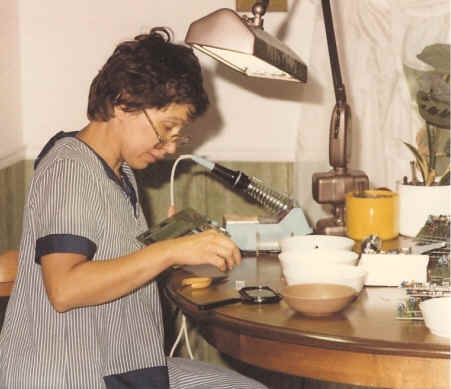
From the Gene and Gloria McDowell Collection
at SMECC
Gloria McDowell tells us: "Getting up in the morning to
work - I was soldering pocket phones at my house before it merged with
C-Phone"


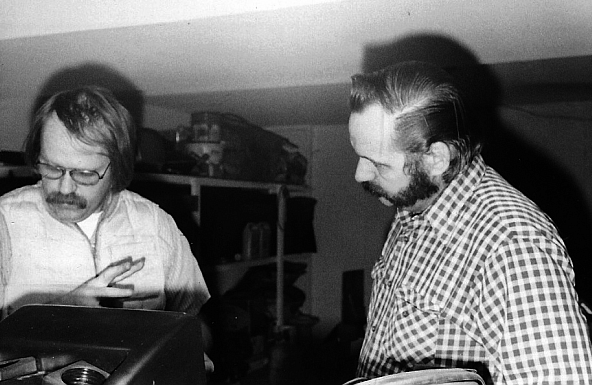
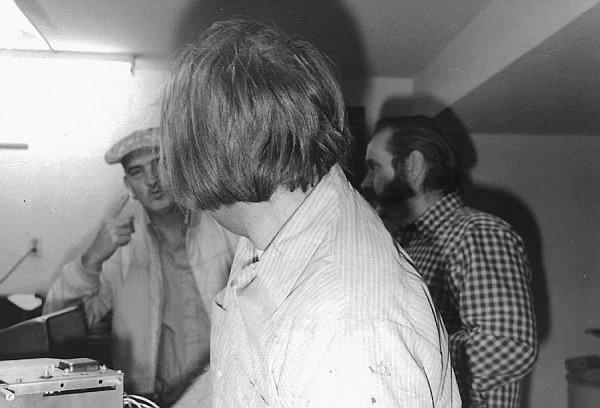
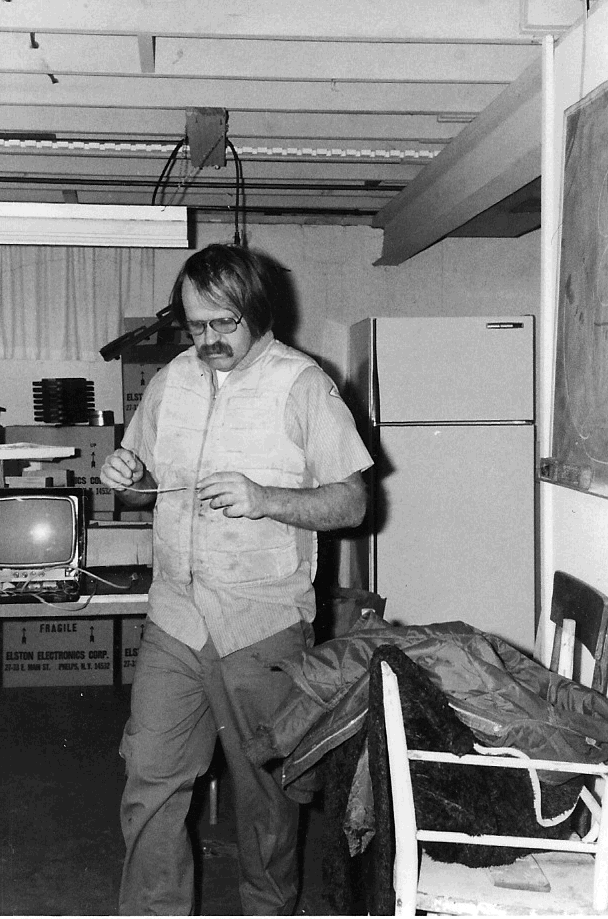
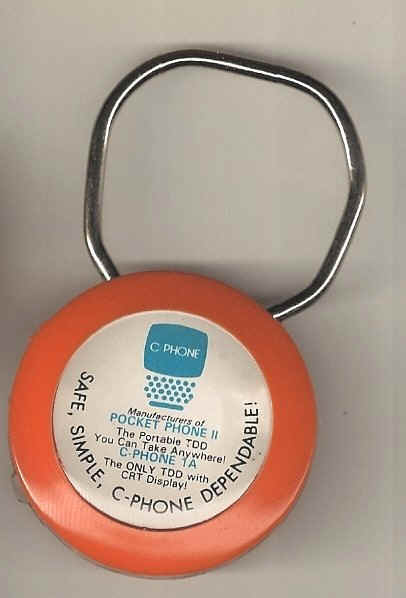
From the Gene and Gloria McDowell Collection
at SMECC
|
|
|
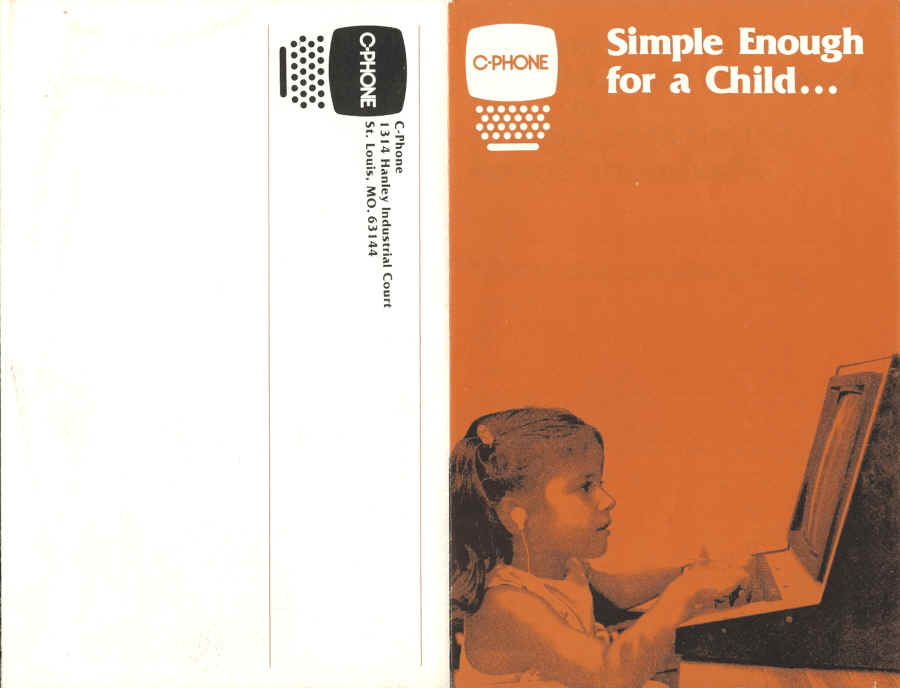
From the Paul and Sally Taylor Collection at
SMECC.
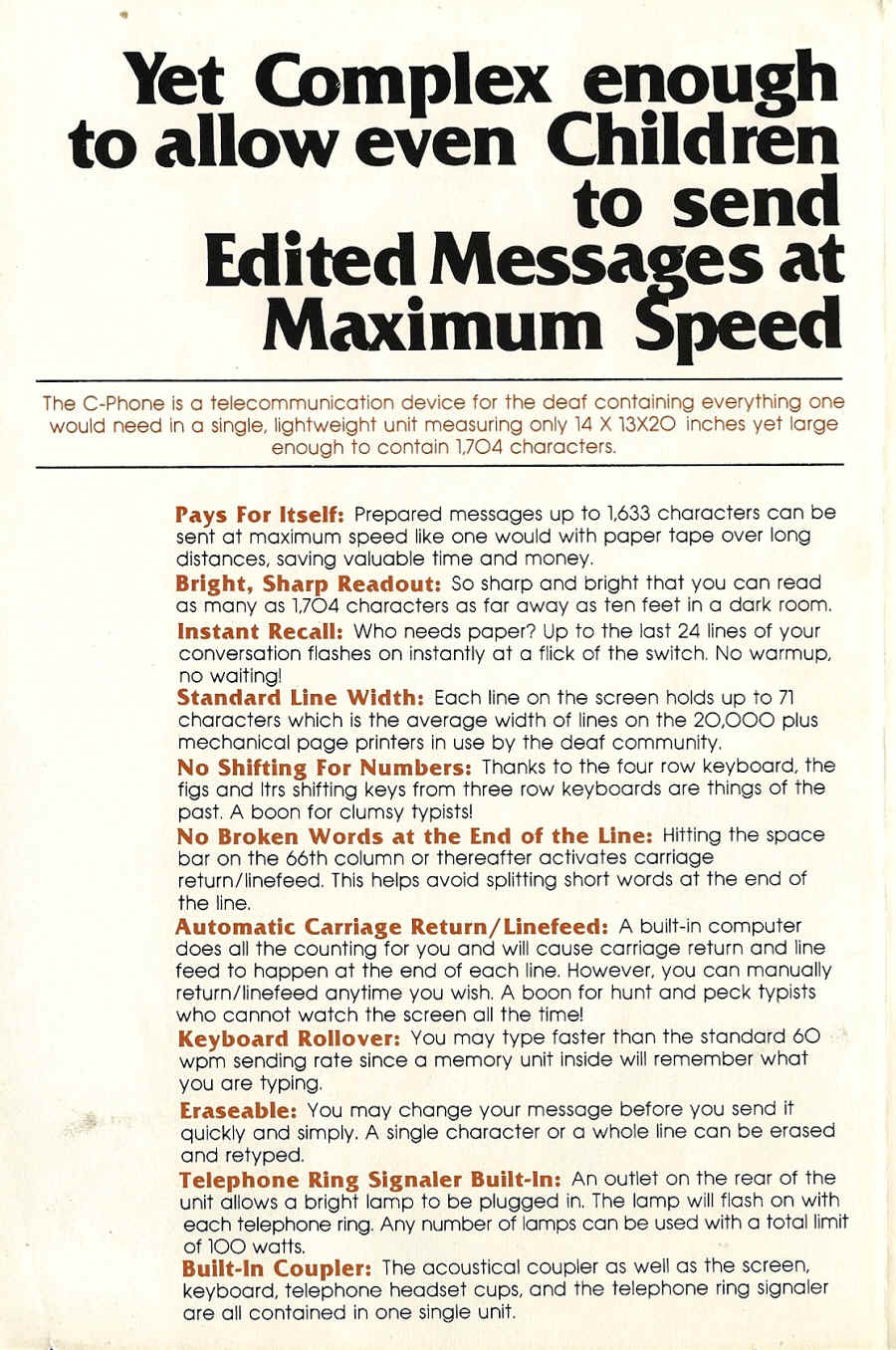
From the Paul and Sally Taylor Collection at
SMECC.
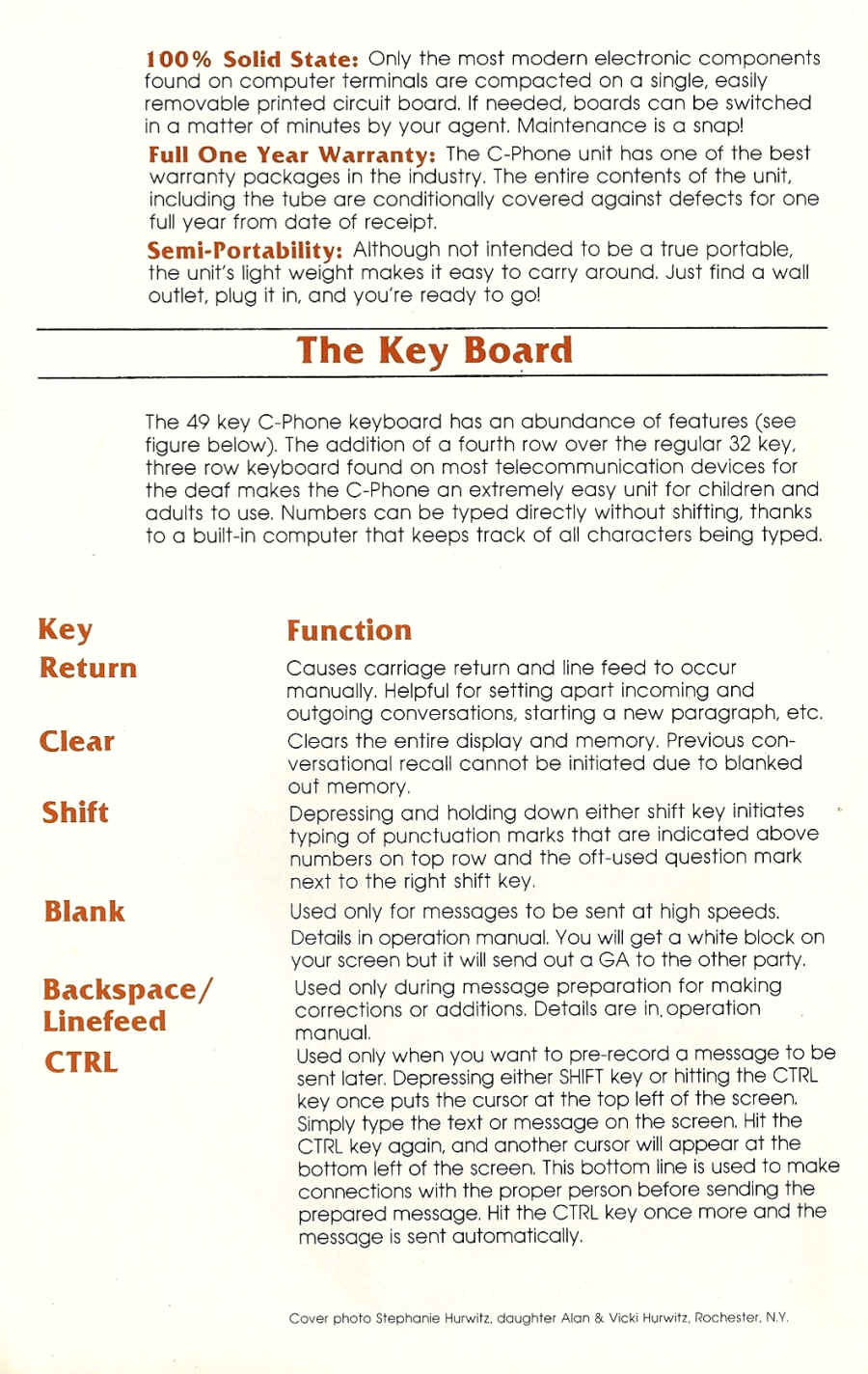
From the Paul and Sally Taylor Collection at
SMECC.
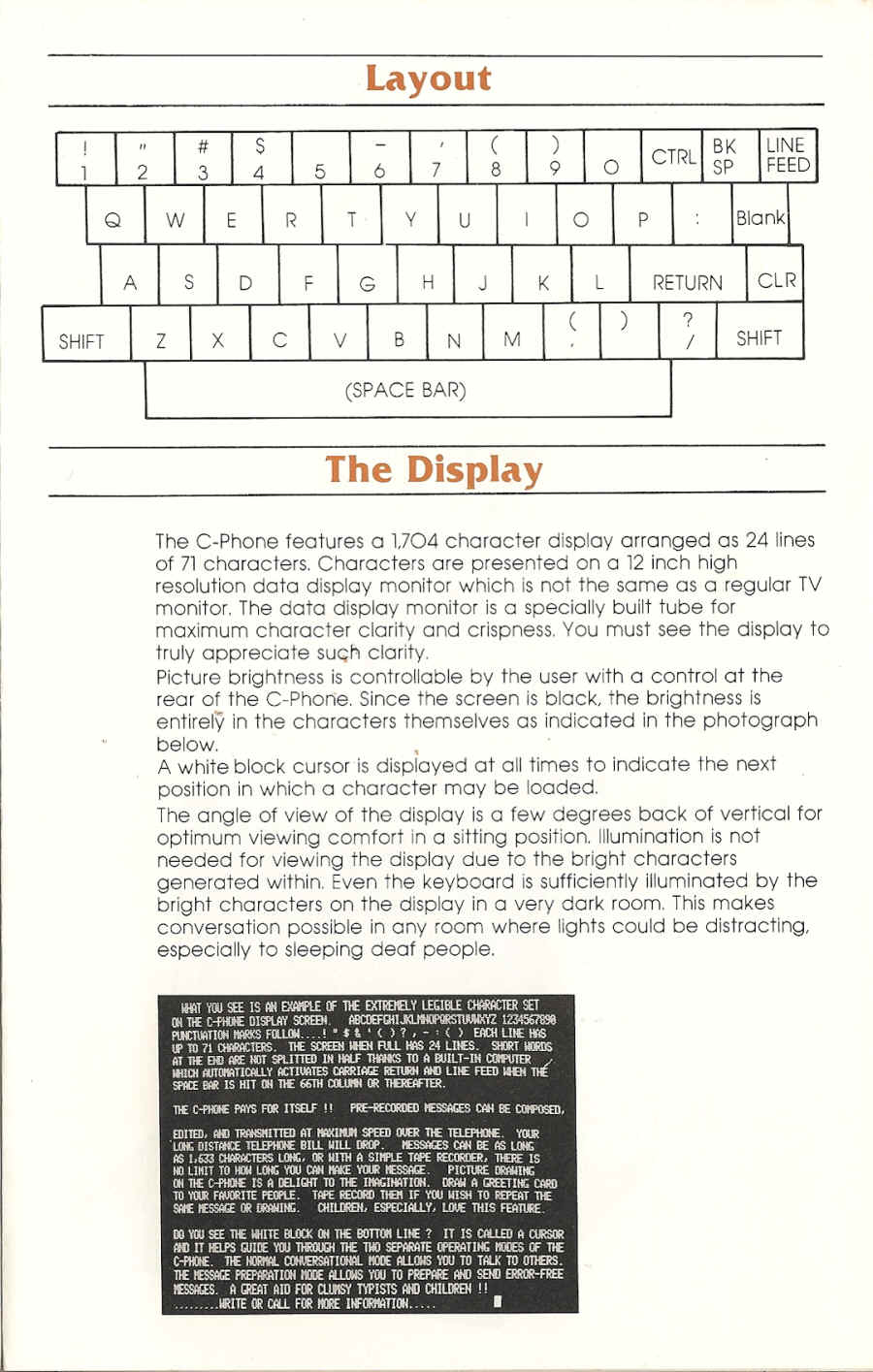
From the Paul and Sally Taylor Collection at
SMECC.
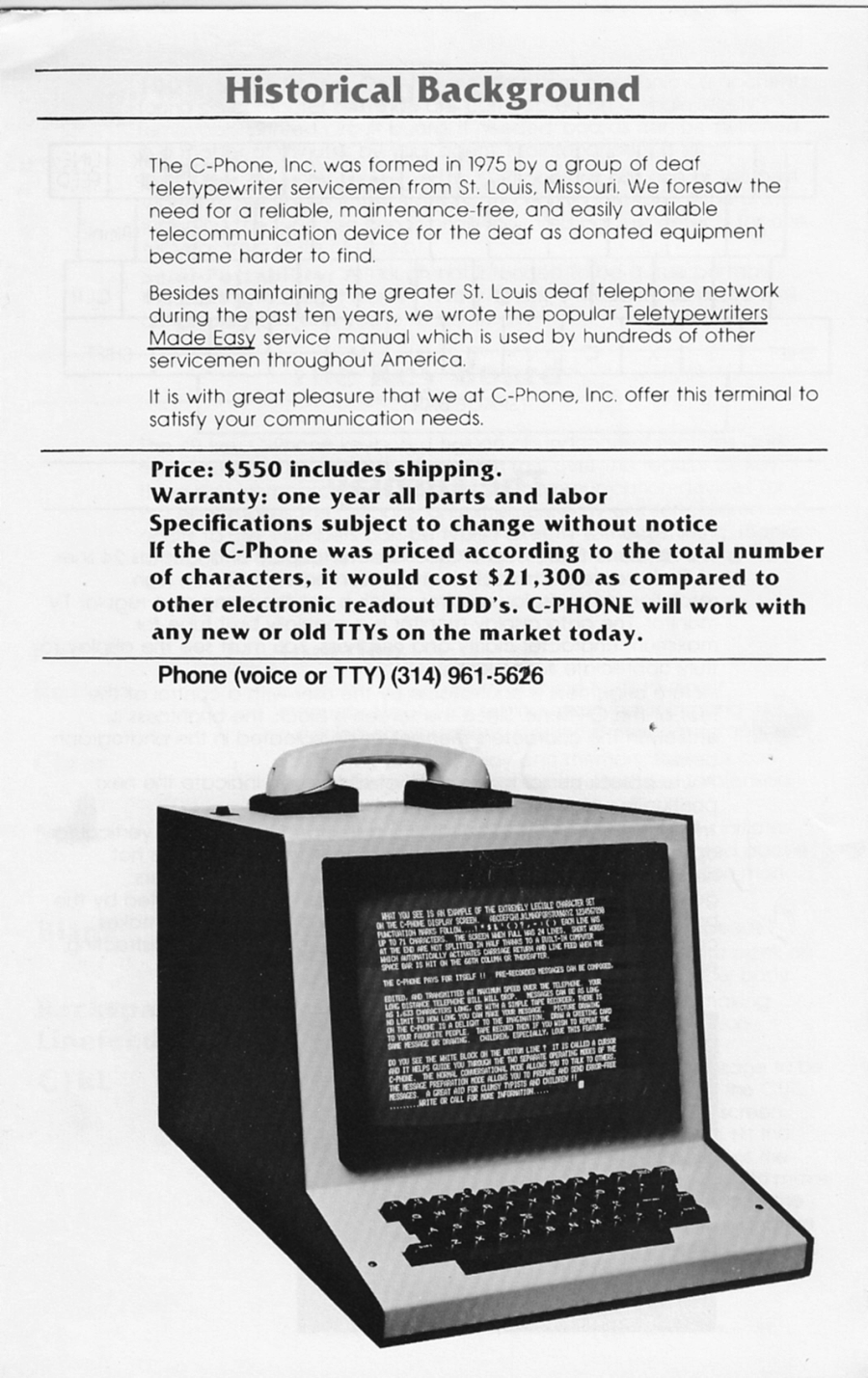
C-Phone Brochure- From the TDI International Telephone Directory of
the Deaf from the Paul and Sally Taylor Collection at
SMECC.
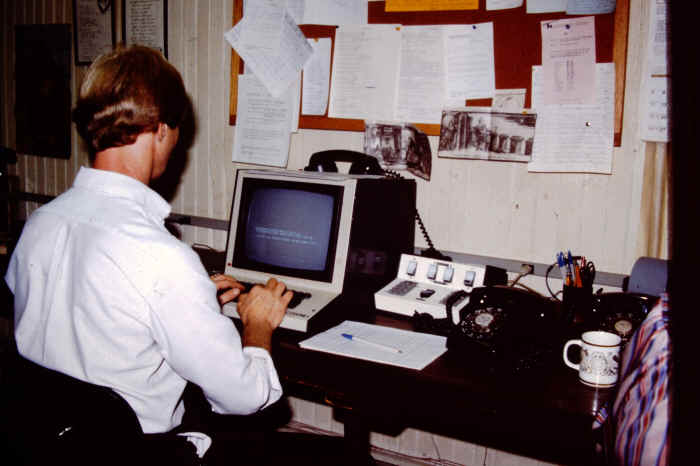
C- SMECC From the Paul and Sally Taylor Collection at
SMECC
C-Phone In use
Sally Taylor tells us - "In this
photo the C-Phone was used by a relay service set up in Rochester, New
York... Called the “Hi-Line Answering Service”, it operated for
several years with limited hours, such as from 8 to 5 Monday through
Friday, and no weekend calls. This service was managed by the Monroe
County Association for the Hearing-Impaired. Eventually Paul pushed for a
24/7 service, and it went nation-wide, thanks to the signing of the ADA in
1990."
|
|
to see or order a copy of this photo
from the Baltimore Sun see this link
http://www.zazzle.com/cr/buffet/sr-250964826716825098?ax=Dialog&cg=196104422888141337&ed=True&br=True&r=9340043
|
Metropolitan Transit Authority
Teletypewriter Phone -1
Bus talk for hearing-impaired
Alan Winn, of the MTA demonstrates teletypewriter phone service that will allow the
hearing-impaired obtain immediate responses to questions, suggestions or complaints. Deaf
bus passengers can call 539-3497; ride-sharers, 859-POOL.
By Ralph L Robinson - Evening Sun Staff
FEB 2 1982 E
|
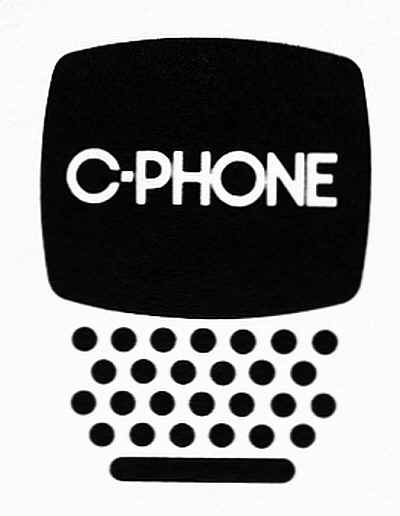
From TDI International Telephone Directory of
the Deaf from the Paul and Sally Taylor Collection at
SMECC
|
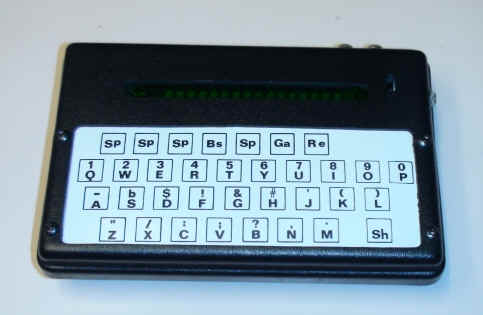
Pocket Phone from the Zimet/Black
Collection at SMECC
With POCKET-PHONE, you or your loved
ones
need never be without telecommunication.
|
|
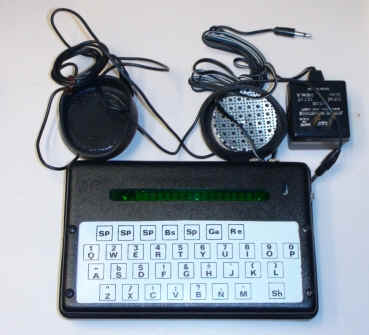
Pocket Phone from the Zimet/Black
Collection at SMECC
|
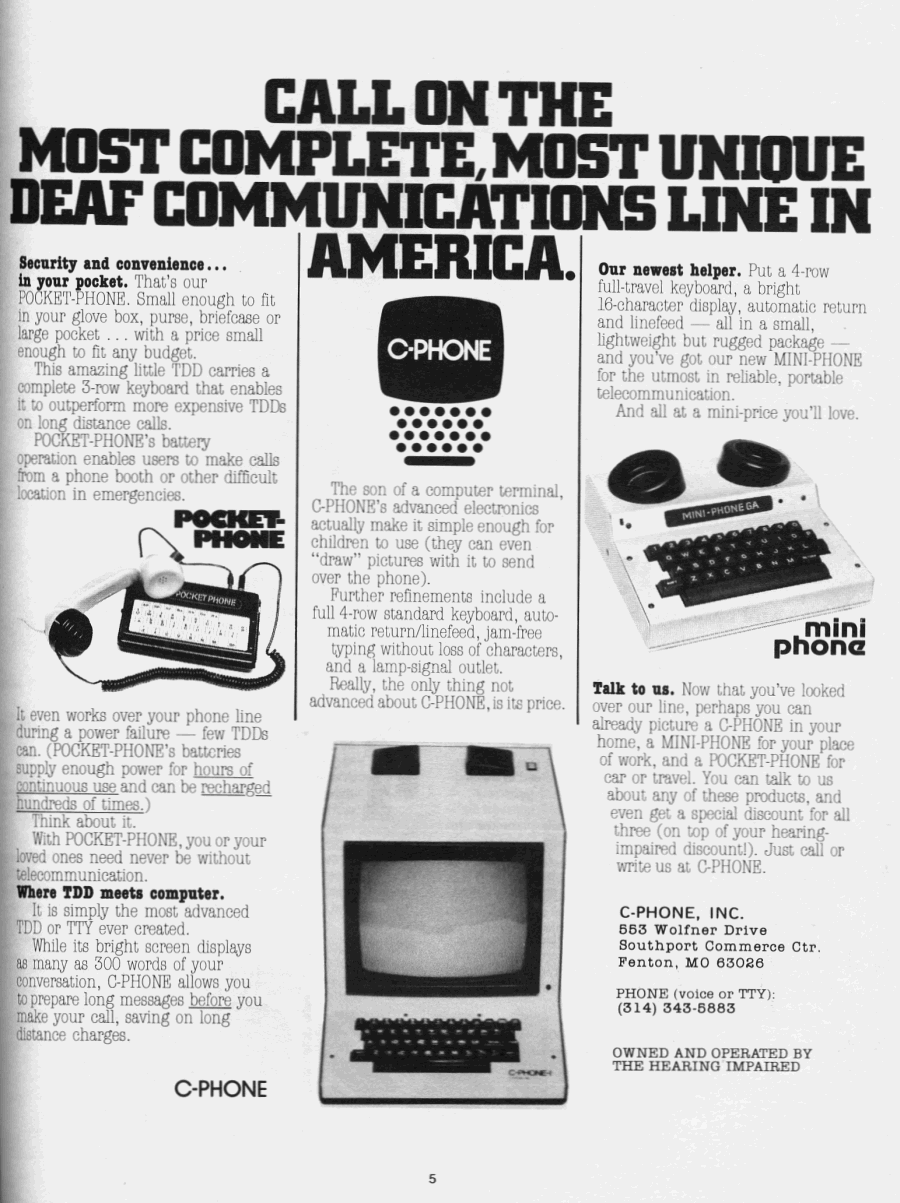
From the TDI International Telephone Directory of
the Deaf from the Paul and Sally Taylor Collection at
SMECC.
CALL ON THE MOST COMPLETE, MOST UNIQUE DEAF
COMMUNICATIONS LINE IN AMERICA.
Security and convenience... in
your pocket. That's our POCKET-PHONE. Small enough to fit in your
glove box, purse, briefcase or large pocket. . . with a price small enough
to fit any budget.
This amazing little TDD carries a complete 3-row keyboard that enables
it to outperform more expensive TDDs on long distance calls. POCKET-PHONE's
battery operation enables users to make calls from a phone booth or other
difficult location in emergencies.
It even works over your phone line during a power failure - few TDDs
can. (POCKET-PHONE's batteries supply enough power for hours of continuous
use and can be recharged hundreds of times.)
Think about it.
With POCKET-PHONE, you or your loved ones need
never be without telecommunication.
Where TDD meets computer.
It is simply the most advanced TDD or TTY ever
created. While its bright screen displays as many as
300 words of your conversation, C-PHONE allows you to prepare long
messages before you make your call, saving on long distance charges.
C-PHONE
The son of a computer terminal, C-PHONE's advanced electronics actually
make it simple enough for children to use (they can even "draw"
pictures with it to send over the phone).
Further refinements include a full 4-row standard keyboard, automatic
return/linefeed, jam-free typing without loss of
characters, and a lamp-signal outlet.
Really, the only thing not advanced about
C-PHONE, is its price.
Our newest helper. Put a 4-row full-travel keyboard, a bright
16-character display, automatic return and linefeed - all in a small,
lightweight but rugged package -and you've got our new MINI-PHONE for the
utmost in reliable, portable telecomm communication.
And all at a mini-price you'll love.
Talk to us. Now that you've looked over our line, perhaps you
can already picture a C-PHONE in your home, a MINI-PHONE for your place of
work, and a POCKET-PHONE for car or travel. You can talk to us about
any of these products, and even get a special
discount for all three (on top of your hearing
impaired discount!). Just call or write
us at C-PHONE.
C-PHONE, INC.
553 Wolfner Drive Southport Commerce Ctr.
Fenton, MO 63026
PHONE (voice or TTY): (314) 343-xxxx
OWNED AND OPERATED BY THE HEARING IMPAIRED
|
|
|
|
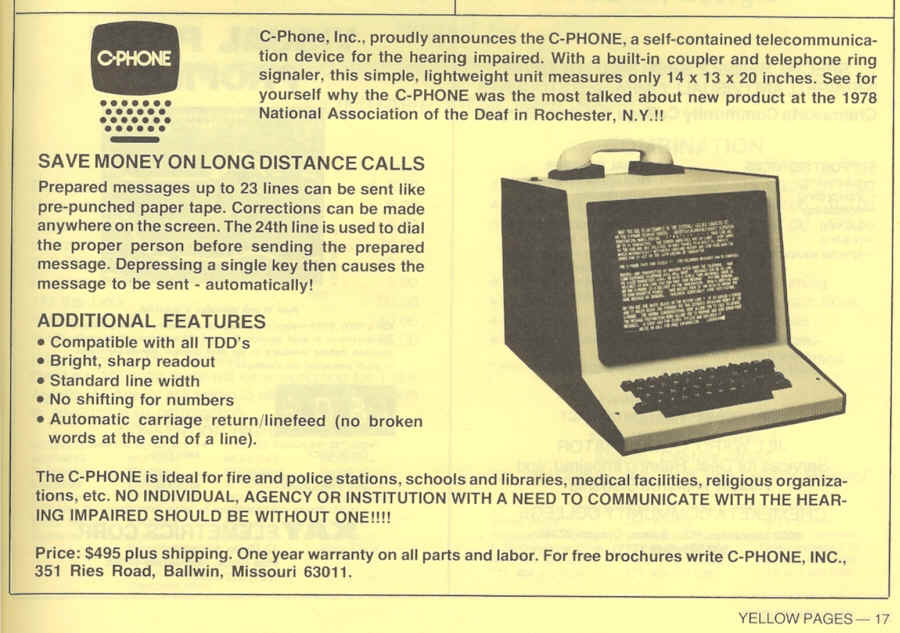
From the TDI International Telephone Directory of
the Deaf from the Paul and Sally Taylor Collection at
SMECC.
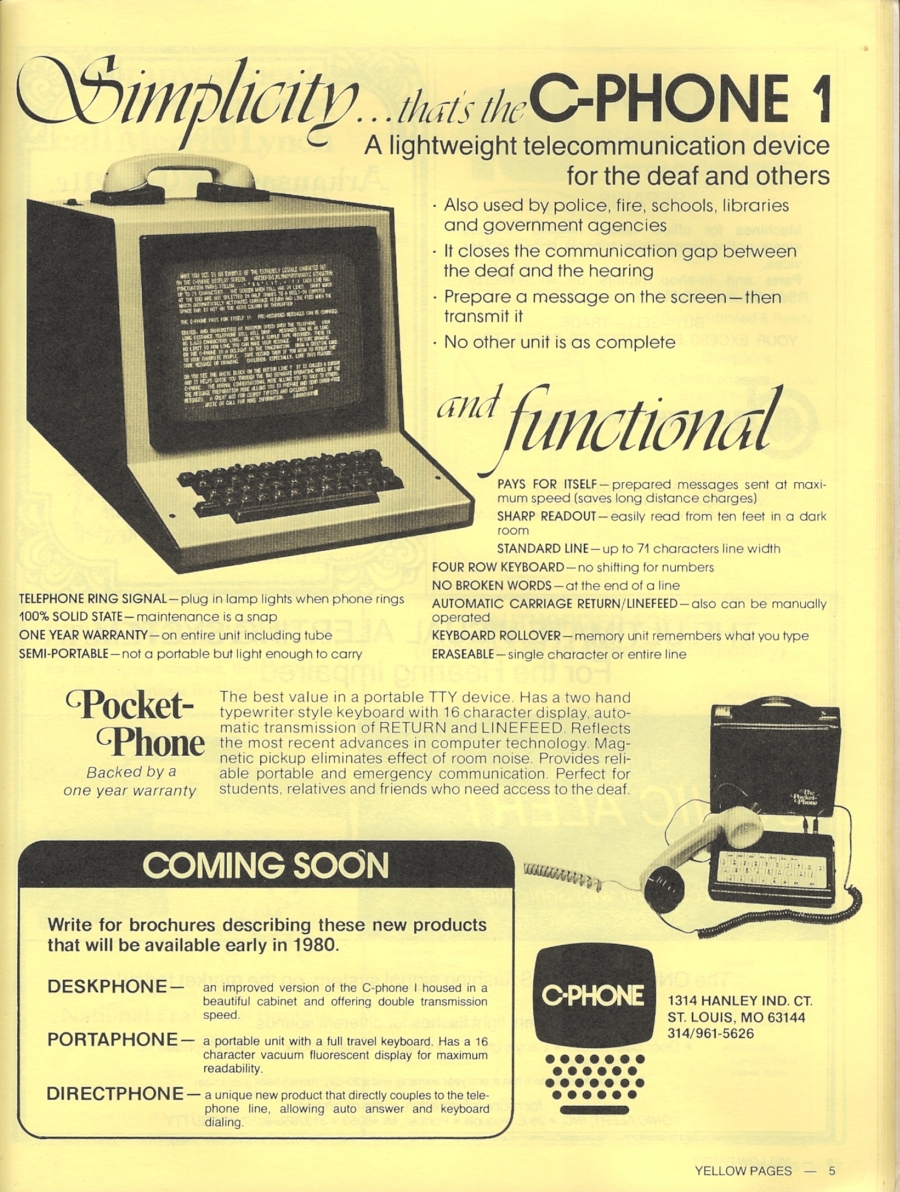
From the TDI International Telephone Directory of
the Deaf from the Paul and Sally Taylor Collection at
SMECC.
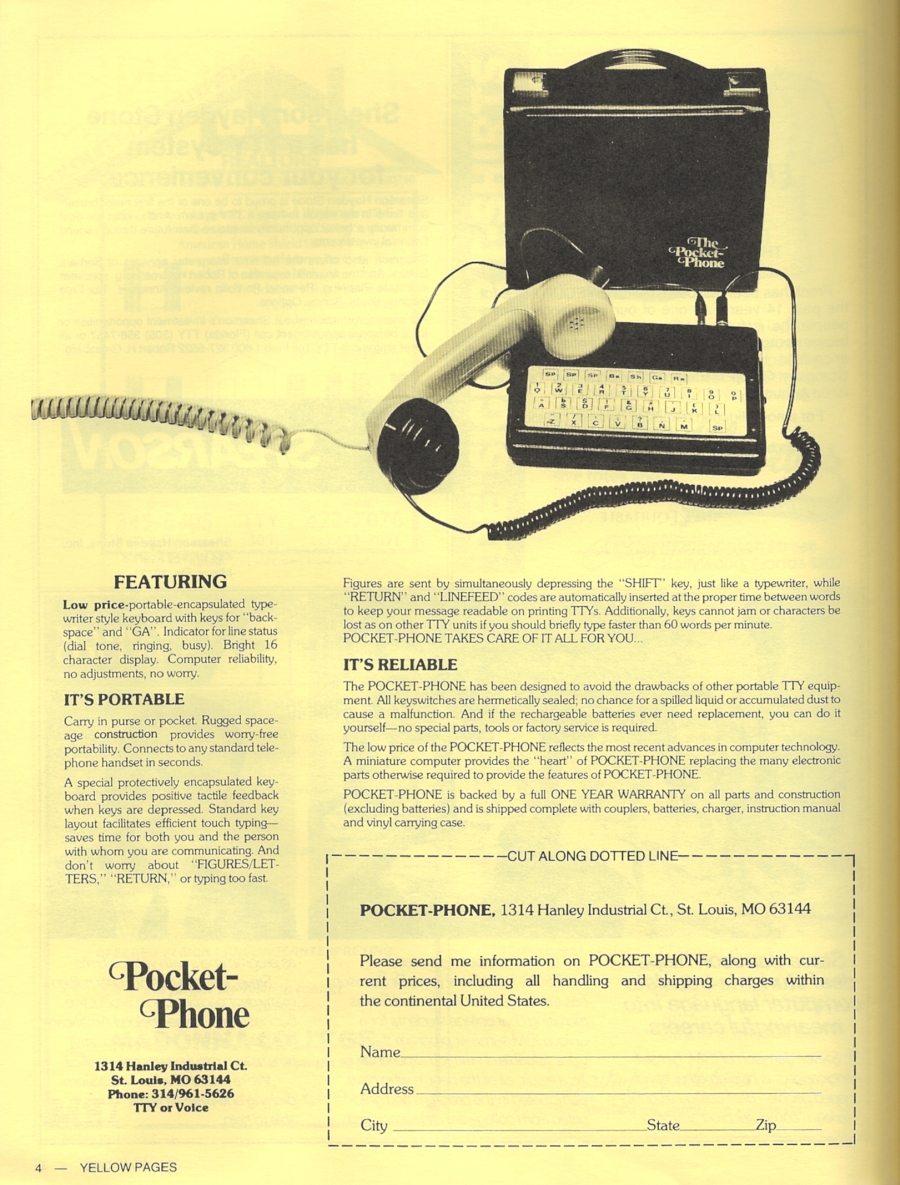
From the TDI International Telephone Directory of
the Deaf from the Paul and Sally Taylor Collection at
SMECC.
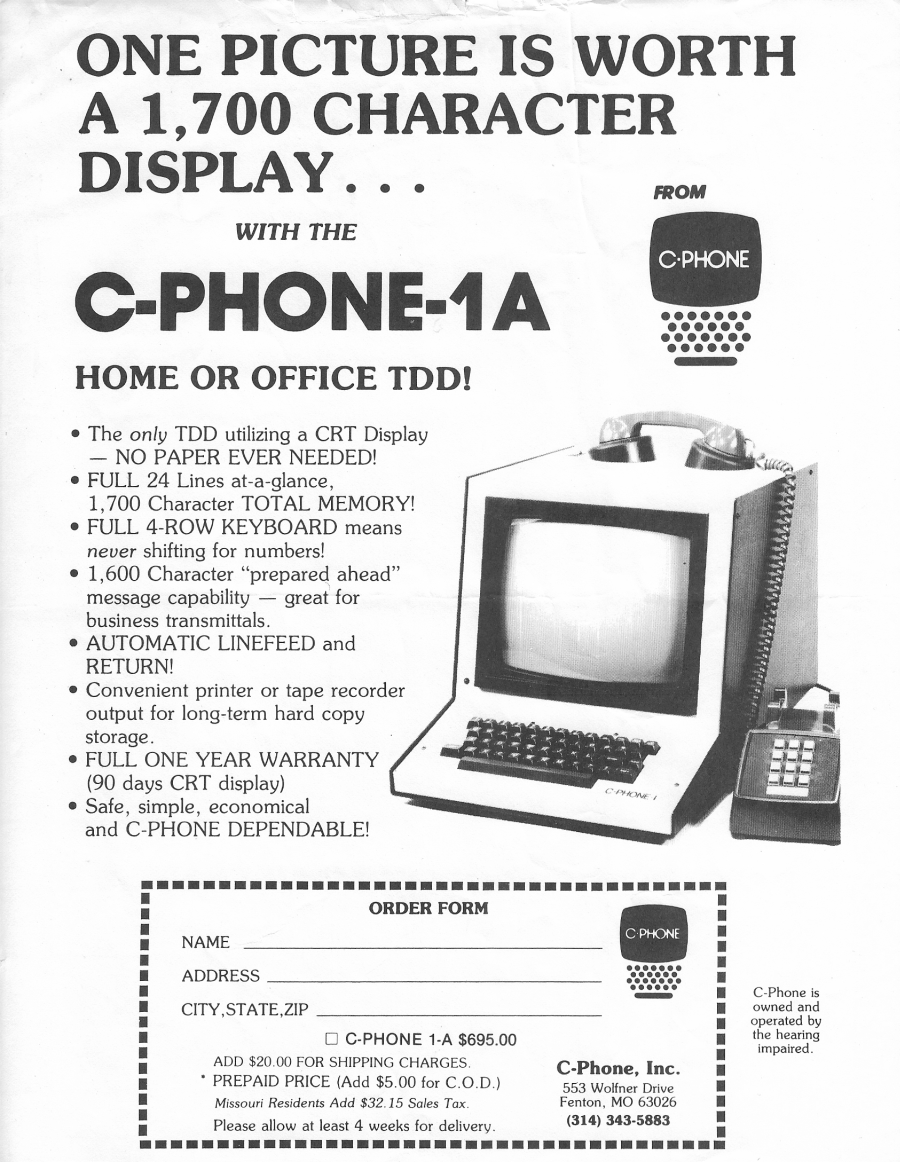
From the Gene and Gloria McDowell Collection as SMECC
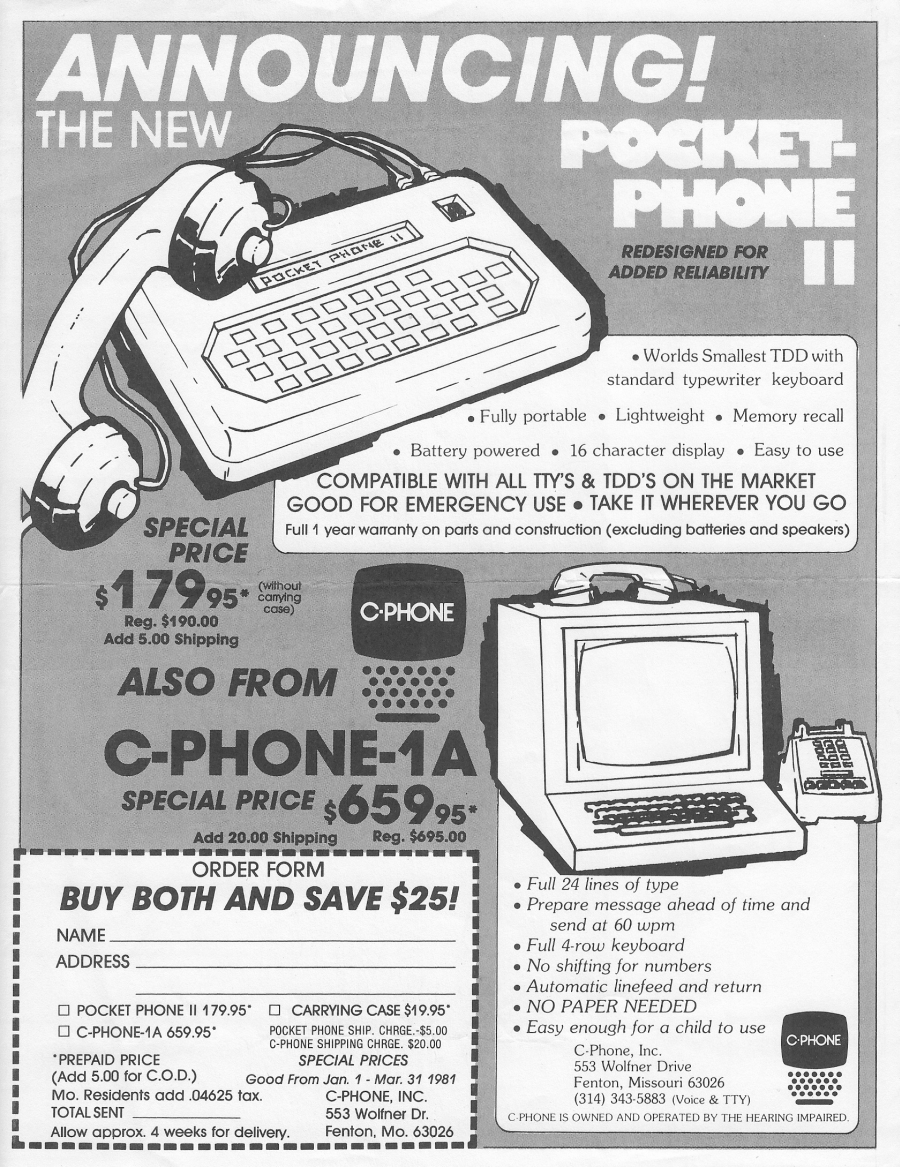
From the Gene and Gloria McDowell Collection as SMECC

From the Gene and Gloria McDowell Collection as SMECC
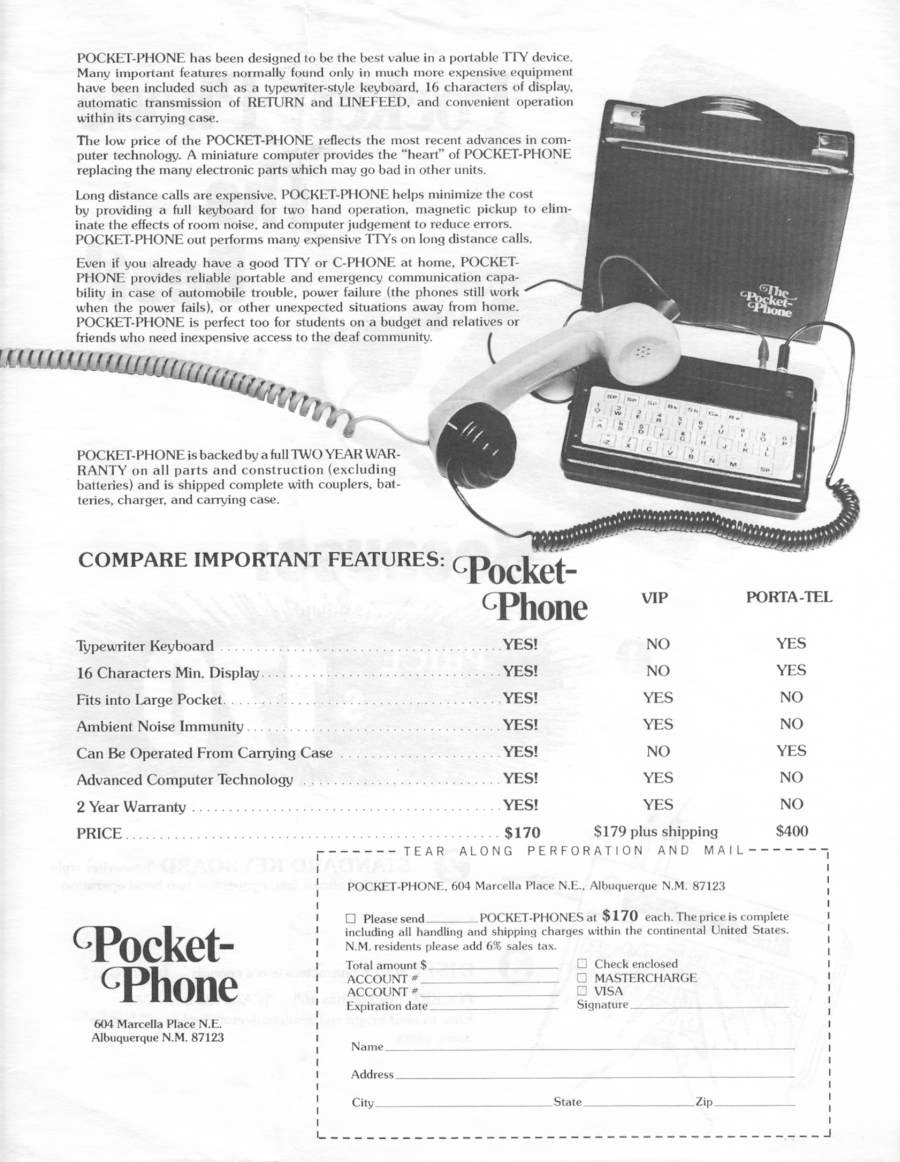
From the Gene and Gloria McDowell Collection as SMECC
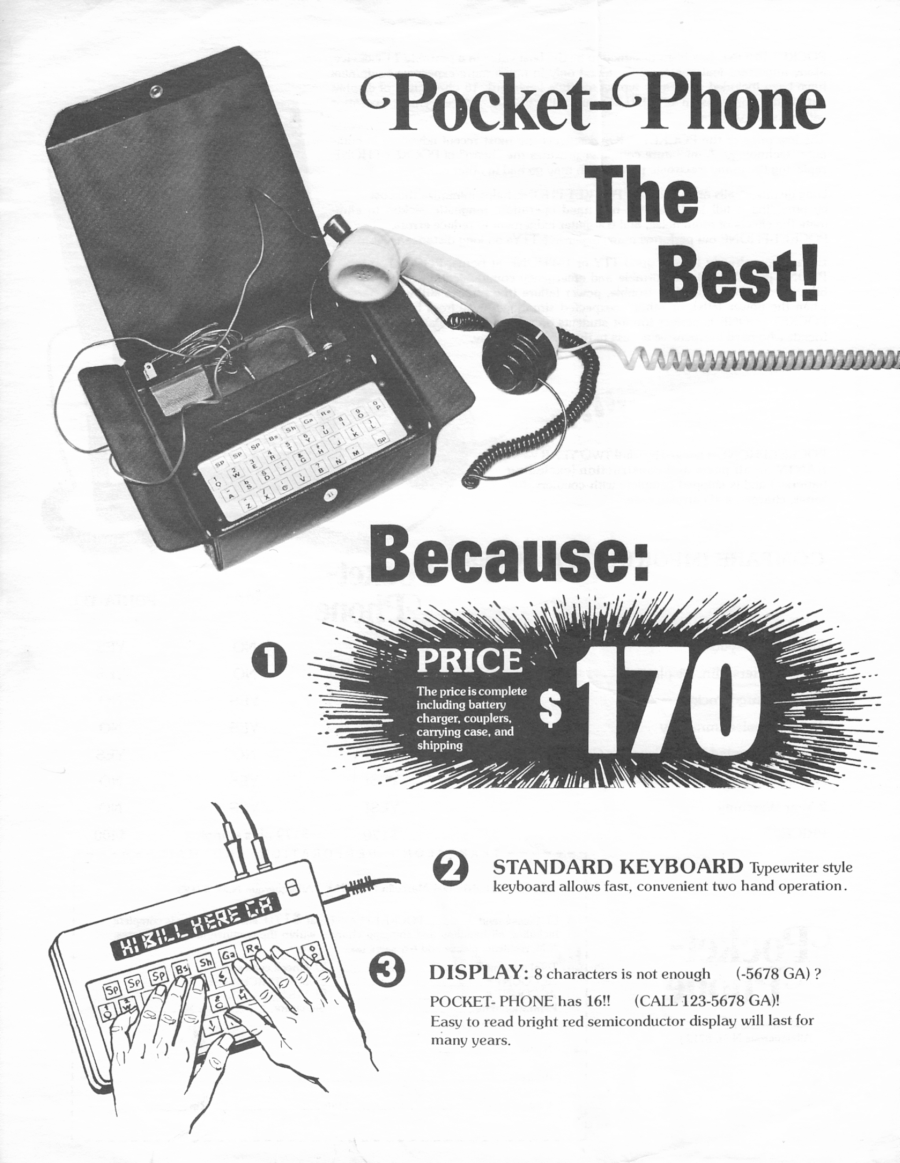
From the Gene and Gloria McDowell Collection as SMECC
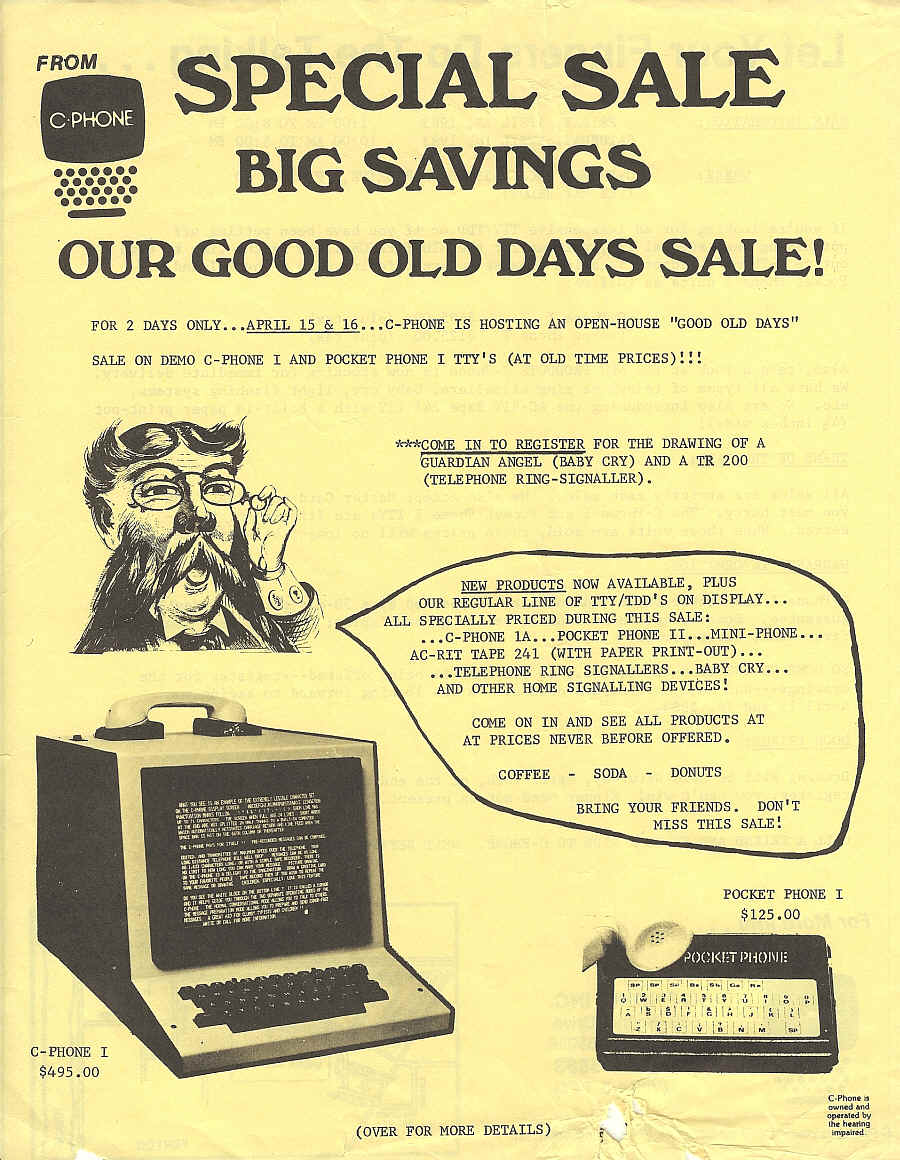
From the Gene and Gloria McDowell Collection as SMECC
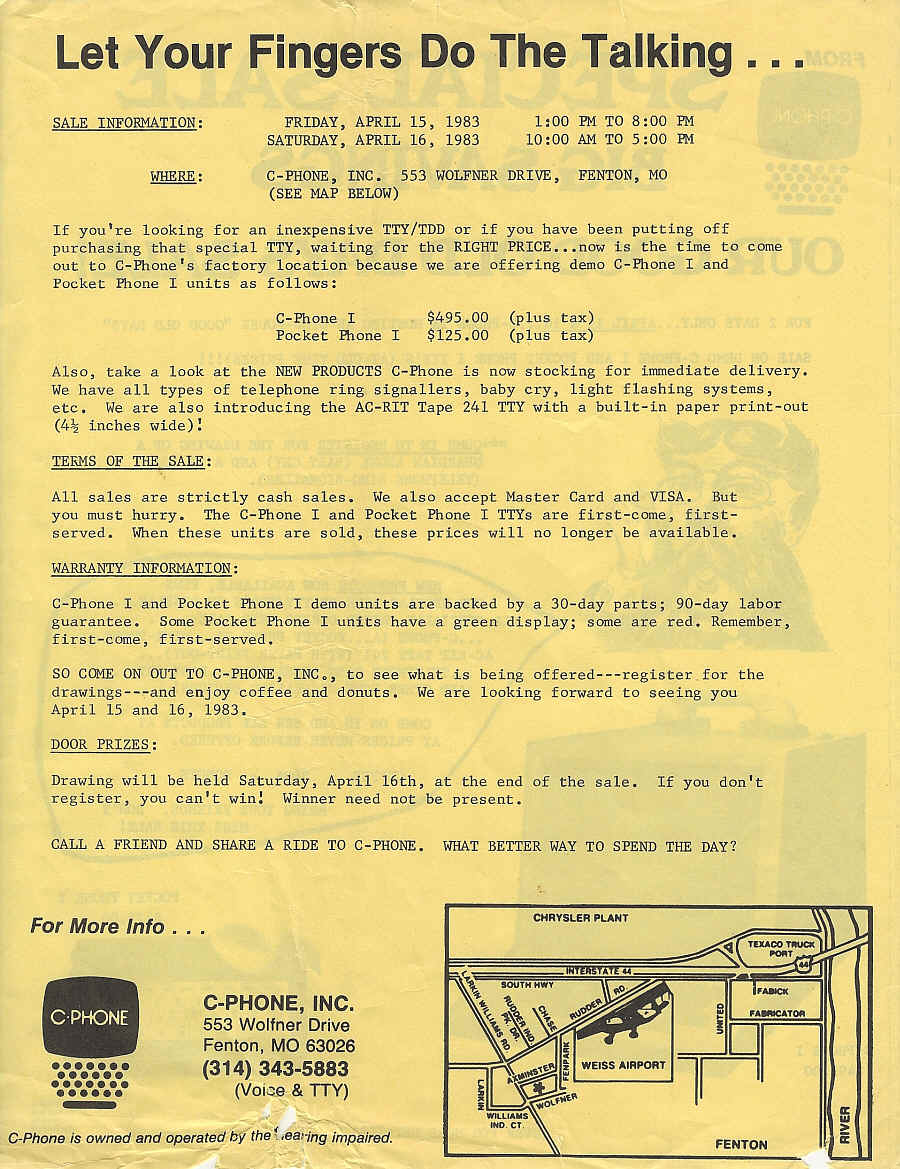
From the Gene and Gloria McDowell Collection as SMECC
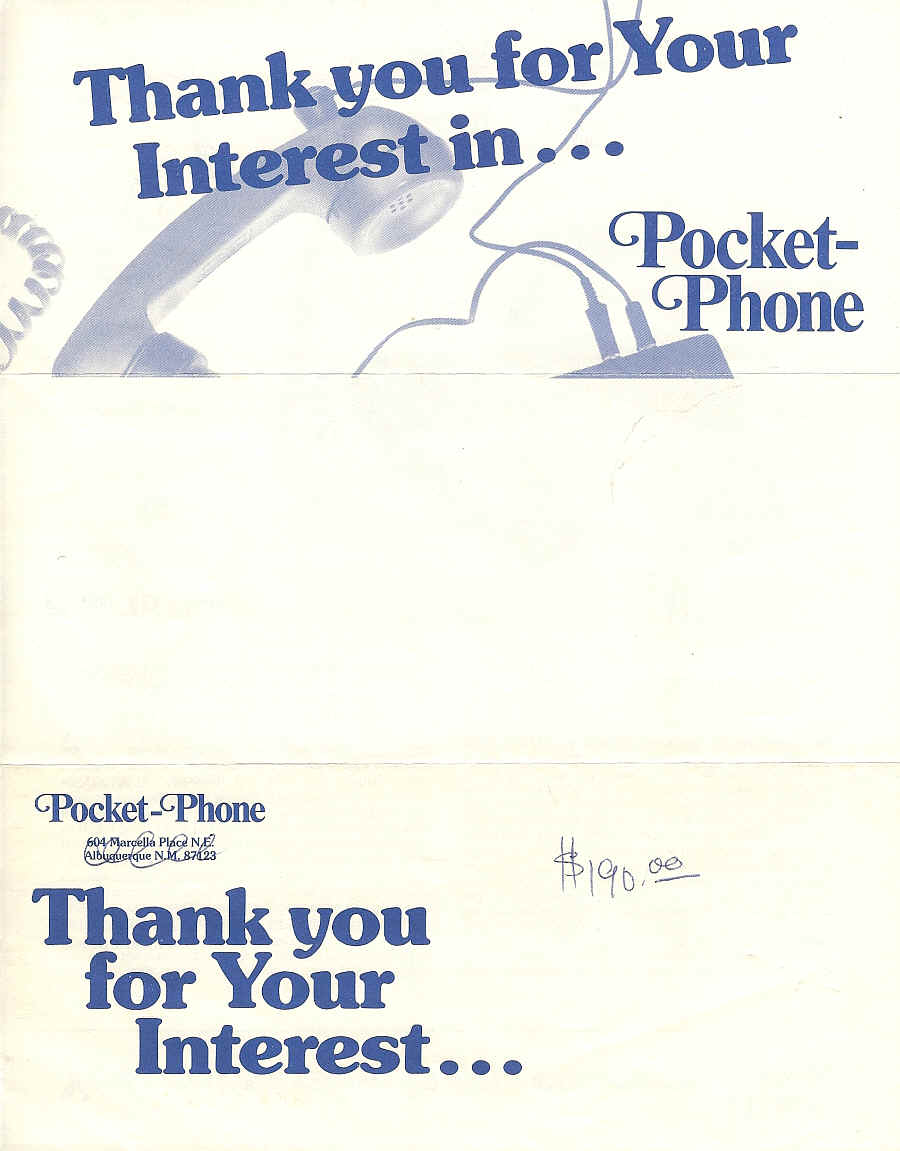
From the Gene and Gloria McDowell Collection as SMECC
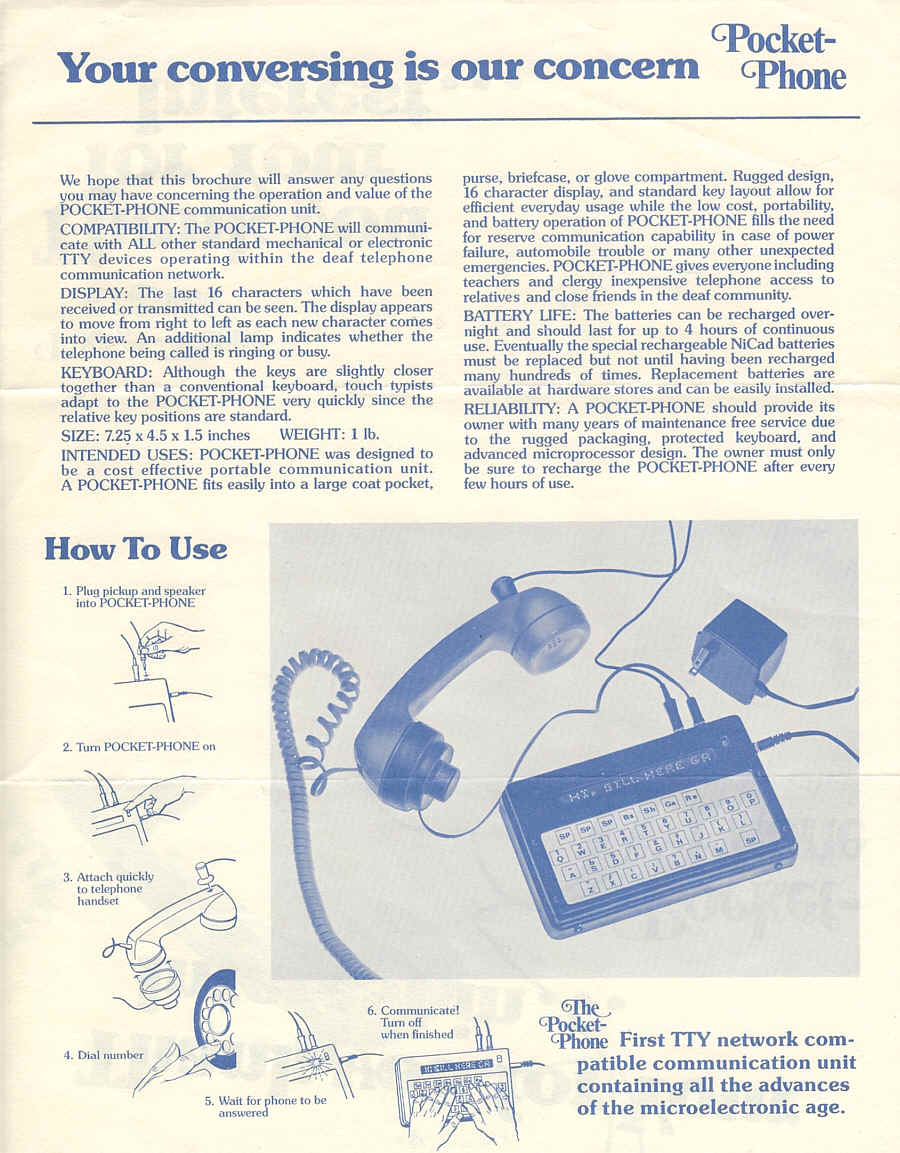
From the Gene and Gloria McDowell Collection as SMECC
The Final C-PHONE Product Offerings
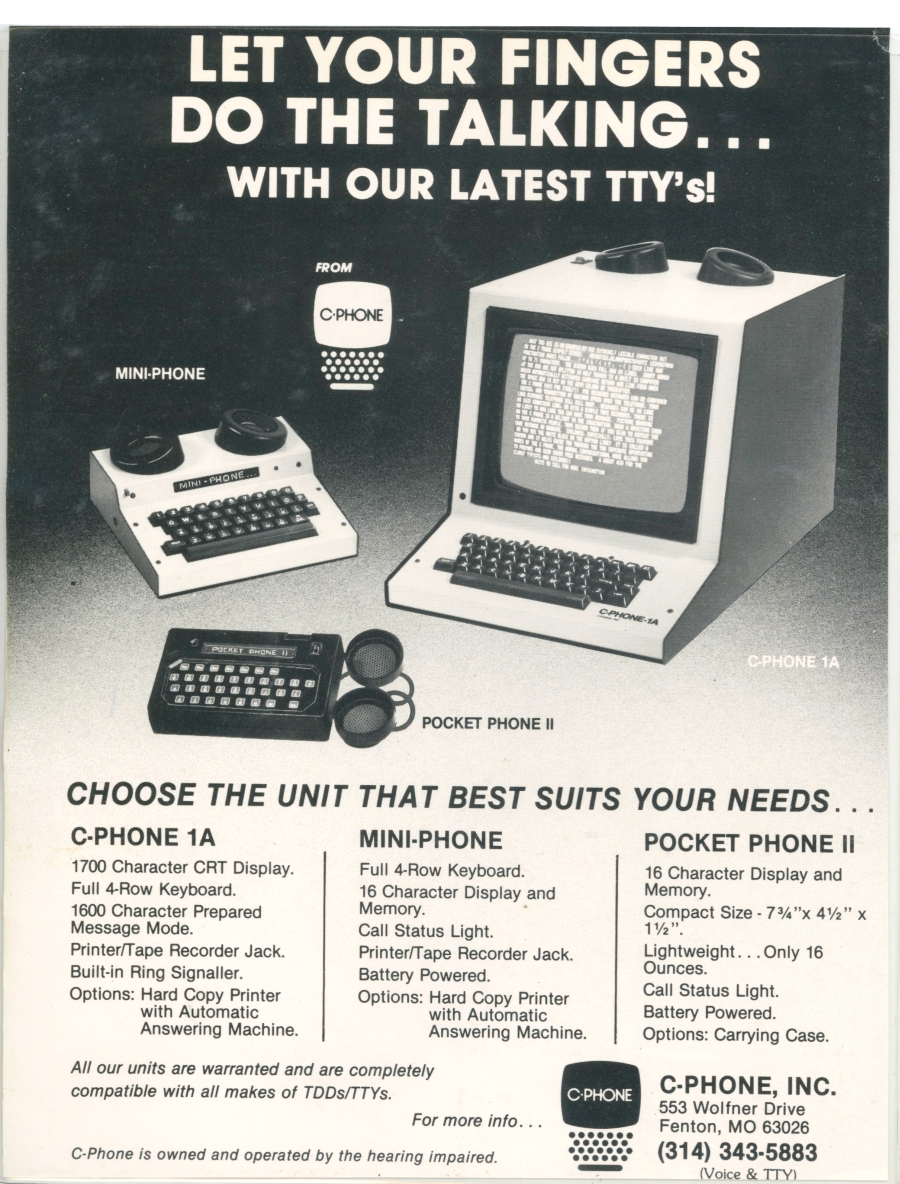
From the NAD1982 Program Back Cover
- from the Paul and Sally Taylor Collection at
SMECC
Sally Taylor relates: These two pages were in another photo album I had (of Rochester people, etc.) and I was surprised to find this CPhone Ad which was in the 1982 NAD program book, seven years after we moved to Rochester.
I told Paul that apparently the CPhone business in St. Louis went longer than we thought. Paul had mentioned to you some time ago that because we were not in St. Louis anymore, he couldn't work with the CPhone guys and it eventually "petered out" mainly because other portable TTYs were being developed, and there was no money for CPhone to develop more. And we thought it was shortly after we moved to Rochester.
Too bad none of the St. Louis guys are alive now. Gene McDowell, the closest one, died just last Spring. We flew to St. Louis for his funeral. I doubt any of the stuff is still around. Tom Schwarz died long ago. Also Fred Stewart. I could ask Merle Reekers but he was not quite that involved. He might know something so I'll try.
Paul's memory has faded on this....happened so long ago, and he had moved to Rochester to start a new career in the middle of all this, so a lot of things don't stick to his mind. David Sharon died in a plane crash. Gene Mc Dowell and Tom Schwarz who were partners with Paul are also gone. So sorry we cannot help much with this. But maybe Paul can try to think some more and read some of the stuff to see if it jogs his memory.
==========================================================
In Memory of Eugene L. McDowell Eugene L. McDowell
November 26, 1936 - February 19, 2012
Facts
Born: November 26, 1936
Place of Birth: Mountain View, MO
Death: February 19, 2012
Place of Death: Bridgeton, MO
Memorial Donations
Memorial donations can be made to:
G.S.L.A.D. Greater St. Louis Association of the Deaf
American Parkinson Disease Association, Inc.
Biography
McDowell, Eugene L. "Gene", passed away peacefully at home on Sunday,
February 19, 2012.
He was born the second child of five in Mountain View, Missouri on
November 26,1936. As a small child his family moved to St. Louis.
Throughout life he was a faithful volunteer at the Greater St. Louis
Association of the Deaf and taught Sunday School for the deaf. He was the
first President of Telecommunicators of Greater St. Louis and past
President of C-Phone Inc. He is a member of the Aircraft Owners and Pilots
Association, and a proud union member of the International Association of
Machinists. He is the beloved Husband of 41 years to Gloria McDowell.
Cherished Father of Grant and Kurt (Joung-Sun) McDowell. Precious
Grandfather of Solomon Eugene, his first grandchild. Dear Brother of Ernie
McDowell, Judy (John) Kreitler, the late Beverly and Deanna. Nephew,
Cousin, and friend to many. He was a devoted Husband and a Beloved Father.
He was an avid pilot and boater with a passion for politics. His ashes
will be interred over sky and water at a later date.
Services: Memorial Service will be conducted at West Hills Community
Church, 13250 S. Outer 40, Chesterfield on Monday, 10:30 a.m. In lieu of
flowers contributions may be made to "G.S.L.A.D." Greater St. Louis
Association of the Deaf or to the Parkinson's Disease Foundation.
Visitation Sunday 4-8 p.m. at SCHRADER Funeral Home and Crematory, 14960
Manchester Road at Holloway, Ballwin, MO. Friends may sign the family’s
on-line guestbook at Schrader.com.
Memorial Service
Monday February 27, 2012, 10:30 am at West Hills Community Church
Click for Map and Directions
Visitation
Sunday February 26, 2012, 4:00 pm - 8:00 pm at Schrader Funeral Home and
Crematory
Click for Map and Directions
Memorial Networks™ Partner Provider: Batesville Interactive, All rights
reserved. | Funeral Home Website by Batesville Interactive
|
|